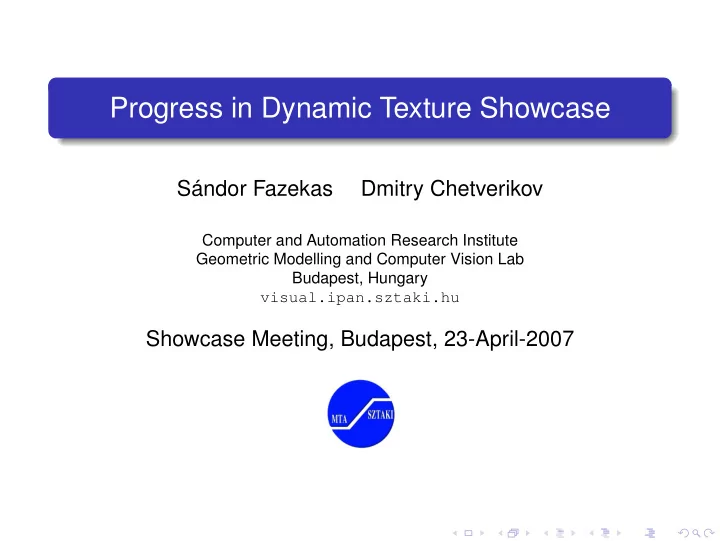

Progress in Dynamic Texture Showcase Sándor Fazekas Dmitry Chetverikov Computer and Automation Research Institute Geometric Modelling and Computer Vision Lab Budapest, Hungary visual.ipan.sztaki.hu Showcase Meeting, Budapest, 23-April-2007
Outline Visual motion and dynamic texture 1 Dynamic texture detection 2 Regular and nonregular optical flows Segmentation using regular and nonregular flows Results 3 Available versions of algorithm 4 5 Summary
Categories of visual motion patterns Activities periodic in time, localised in space ⇒ walking, digging Motion events no temporal or spatial periodicity ⇒ opening a door, jump Temporal textures statistical regularity, indeterminate spatial and temporal extent ⇒ fire, smoke
Examples of dynamic textures regular disturbed mixed ⇒ show sample videos
DynTex database by NoE MUSCLE 656 digital videos PAL 720 x 576, 25 fps Length ≥ 250 frames Closeups and contexts Static/moving camera Indoor and outdoor natural scenes Annotated, categorised (work in progress) Available on the Web ( � 50 registered users) http://www.cwi.nl/projects/dyntex/ ( In collaboration with R. Péteri, M. Huiskes, and CWI )
Non-regular optical flow for dynamic texture Work in progress with Tel-Aviv Unversity (TAU) Tomer Amiaz Nahum Kiryati Dynamic textures have strong intrinsic dynamics motion cannot be compensated by shift/rotation intensity constancy assumption not valid standard (regular) optical flow not precise Use intensity conservation assumption instead non-regular optical flow with divergence term intensity may diffuse Dynamic texture detection segmenting flow into regular and non-regular part indicator function in level-set implementation
Brightness conservation assumption Non-regular optical flow (compared to Horn-Schunck) Brightness constancy: I ( x + u , y + v , t + 1 ) = I ( x , y , t ) Optical flow constraint: I t + uI x + vI y = 0 Brightness conservation: I ( x + u , y + v , t + 1 ) = I ( x , y , t )( 1 − u x − v y ) I t + uI x + vI y = − I · ( u x + v y ) Continuity equation: Brightness of an image point (in one frame) can propagate to its neighborhood (in the next frame) Captures more information than a regular flow Encodes the warp residual of a regular flow Applicable to strong dynamic textures (generic feature)
Optical flow equations Horn-Schunck brightness constancy ( v = ( u , v ) : velocity vector) ∂ t I + v · ∇ I = 0 Lagrangian L HS ( u , v ) = ( I t + uI x + vI y ) 2 + α ( u 2 x + u 2 y + v 2 x + v 2 y ) minimise F HS ( u , v ) = � I L HS ( u , v ) d x d y Brightness conservation ∂ t I + v · ∇ I + I div v = 0 Lagrangian more complicated, but essentially similar
More precise motion compensation by nonregular flow a) b) c) d) e) f) (a,d): frame 1 of dynamic texture; (b,e): frame 2 warped back by regular flow; (c,f): same by non-regular flow
Level set segmentation Segmentation as a variational problem L DTS ( u , v , ˜ u , ˜ v , φ ) = ( I t + uI x + vI y ) 2 H ( φ ) + ( I t + ˜ v y ) 2 H ( − φ ) uI x + ˜ vI y + I ˜ u x + I ˜ u 2 + ˜ + α ( u 2 x + u 2 y + v 2 x + v 2 u 2 u 2 v 2 v 2 y ) + ˜ v 2 ) α (˜ x + ˜ y + ˜ x + ˜ β (˜ y ) + ˜ + ν |∇ H ( φ ) | Z F DTS ( u , v , ˜ u , ˜ L DTS ( u , v , ˜ u , ˜ v , φ ) = v , φ ) d x d y I Brightness constancy on static and weak dynamic regions Brightness conservation on strong dynamic regions Smooth boundary of segmented regions Solved (Euler-Lagrange eqs., discretisation based on central derivatives, iterative solver, . . . )
Results ⇒ show sample videos
Versions: Making it faster Full algorithm precise segmentation no thresholding needed (decision by indicator function) currently, slow (15–20 sec/frame) ⇒ make faster using graph cuts Fast simplified version less precise segmentation threshold learned, then adjusted adaptively close to real-time (5–10 fps) Real-time simplified version less precise segmentation, sometimes errs threshold adjusted adaptively real-time (20–25 fps)
Summary Collaborative work of SZTAKI and TAU Showcase with Bilkent Generic method for detecting dynamic textures processes of various physical origin More than just detection/segmentation calculates optical flow useful for recognition Plans speed up full algorithm (graph cuts) improve real-time version: automatic threshold, adaptivity distinguish between DTs and other fast motion integrate with periodicity detection and DT recognition
Recommend
More recommend